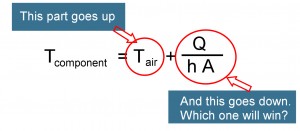Answers to those Doggone Thermal Design Questions
By Tony Kordyban
Copyright by Tony Kordyban 2004
Greetings,
We make a special home entertainment electronic product that sits close to the customer’s TV. It allows you to get satellite TV service for a very low price. The catch is that our box records all the programs overnight, speeds them up by about 10%, and inserts more commercials into the extra time slots. And the remote control has no fast forward button.
Diabolical, no? But that is not my thermal question.
The programs are stored on a disk drive. The datasheet for the disk drive says that it works in a “still air environment up to 35°C.”
Our typical customers often do not have air conditioning in their homes, and during the summer nights the room temperature can get as high as 40°C.
I am thinking that I can add a fan to our satellite-recorder box. The fan would cool the disk more than the “still air.” That would allow it to work, even if the room temperature is higher than the operating limit in the datasheet. Is there a Rule of Thumb that tells me how many °C of cooling I get for every liter per second of air flow?
Crazy Ed from the Stereo Seraglio
*** October 2013 Update ***
When I reviewed this article, first posted on CoolingZone in June 2004, I found more than just a few typos and spelling mistakes. The answer didn’t match the question! The answer mentions air conditioning several times, even though poor Crazy Ed was only asking about fans. In the editing process I unintentionally stitched together a question from one article with the answer from another.
For this new posting I have written a fresh answer. So if it does not match your recollection of this article from the good old days of 2004, now you know why. And I have to say you are way, way too interested in this topic.
*** October 2013 Update ***
Dear Crazy,
You are really asking me two very different questions:
- Is it technically possible to make electronics work at an ambient temperature higher than it is rated for by adding a fan?
- Is it a good idea?
It’s like asking me if you can use a power lawn mower to trim a hedge. From a technical point of view, sure. It has plenty of power to neatly cut through the thickest branches of a hedge, and the blade is plenty sharp enough to do the job. But is it a good idea? Because it can also neatly sever your fingers and other limbs, it is an incredibly dangerous misuse of a lawn technology.
Question 1. Technically feasible: Maybe.
Here’s how you could do it.
- Find out the temperatures of all the important, temperature-sensitive components of the disk drive when it is operating in “still air” at 35°C. The easy way is to just ask the disk drive supplier. In another, more real world, the easy way is to run a thermal test yourself, because the supplier probably won’t share this information.
- Run a second thermal test, this time with the ambient air at 40°C. This time apply your cooling fan. Measure the temperature of all the same components while the disk is operating in exactly the same way as before.
- If all the temperatures from Step 2 are less than or equal to the temperatures from Step 1, then you might conclude that it is safe to use the disk drive at 40°C with your fan.
Let’s pretend you did your little test on three components of the disk drive, and the results are shown in this table:
|
Component |
“Still air” T air = 35°C |
Fan T air = 40°C |
|
Controller chip |
60°C |
47°C |
|
Voltage regulator |
55°C |
45°C |
|
Spindle bearing |
45°C |
43°C |
All the temperatures with the fan cooling are lower, so it looks pretty good.
On the other hand, it is possible that your results could look like this:
|
Component |
“Still air” T air = 35°C |
Fan T air = 40°C |
|
Controller chip |
60°C |
47°C |
|
Voltage regulator |
55°C |
45°C |
|
Spindle bearing |
38°C |
41°C |
The spindle bearing in this made-up example is only 38°C in the “still air” environment. When the air temperature is 40°C, no matter how big a fan you blow at it, the spindle bearing temperature can’t go below 40°C. Based on this test, the fan cannot make the disk drive work in 40°C air.
Note that 38°C is probably NOT the maximum operating temperature of the spindle bearing. The problem is you don’t know the real maximum operating temperature. The only thing you know is the disk drive supplier thinks it is OK at 38°C. It might still be fine at 41°C, or even 100°C, but you don’t have that information.
Here is a little bit of theory about why the fan might make the disk drive work at 40°C. The temperature of the surface of the disk drive components is related to the surrounding air temperature by this equation:
T component = component surface temperature
T air = air temperature far away (ambient)
Q component = heat dissipation of the component
h = convection coefficient
A = surface area of the component exposed to the air
When you point a fan at the disk drive you are making the convection coefficient (h) bigger. The faster the air moves, the bigger the value of h. In “still air” we think air is not moving at all. Actually, it does, because the heat from the components makes the local air bouyant, creating a very gentle upward current. To give you an idea of magnitude: h for “still air” is less than 10 W/m2°C. A fan can increase it to 50 W/m2°C or more.
When you increase the air temperature from 35°C to 40°C, maybe your higher value of h can compensate and Tcomponent can still be less than what it was in “still air”. It all depends on what Q, h and A are, which are different for each component.
The fan will definitely make h bigger. But that does not guarantee that the final temperature will be low enough. The end result also depends on the values of Q and A, which you can’t change.
Even if your test ends up like the first table, I still say it only “might” be safe you operate the disk drive at 40°C with the fan, because it depends on a couple of assumptions to be true:
- Assumption 1. That the supplier was correct in claiming the disk drive works in “still air” up to 35°C. I suppose if anybody would know, they ought to, because they have to live with the consequences of high failure rates if they are wrong. But there is no standard definition of “still air”. Is your “still air” test the same as theirs? Some companies test their “still air”-cooled products in a thermal chamber, which might have a circulating fan. Was the disk drive oriented vertically or horizontally? In “still air”, orientation with gravity can double the value of h. Was it sitting on a metal bench that could conduct heat away? In a competitive marketplace your supplier has an incentive to choose a test method that “helps” the drive meet its temperature spec.
- Assumption 2. That you are able to identify all the temperature-sensitive parts in the disk drive. Not so simple, considering most of them are inside the sealed metal housing. Can you get enough data from the parts you can measure on the outside? Maybe, but how would you know until dead disks start coming back from angry customers?
Question 2. Is it a good idea?
The disk drive supplier has given you an incomplete, oversimplified, inadequate thermal spec. To not violate the spec, you have to use it in “still air” no hotter than 35°C. But since “still air” is not clearly defined, and where the 35°C is measured with respect to the disk drive is not defined either, you are already stuck.
You already can’t fully comply with the datasheet, and now you want to go beyond even that vague specification. What you really want to know is how much of a risk are you taking.
Let’s say you did my little thermal test, and you are satisfied that the fan keeps the whole disk drive cooler at 40°C than “still air” does at 35°C. You have a pretty good case to say the risk of using the disk that way is pretty small.
But that’s the problem. You have now taken all the risk onto yourself. Suppose next year the supplier changes the lubricant for its spindle bearing, and that lubricant evaporates above 40°C. The supplier won’t even tell you, because the disk drive still meets its original spec of 35°C “still air”. But in your application it will quickly fail. And who will be responsible?
The best way to solve this dilemma is to write a new specification for the disk drive, requiring it to operate up to 40°C with the air flow rate you intend to provide with your fan. The disk drive supplier might sign up to that spec for a slight increase in price, considering no design changes are even required, just some extra paperwork and a new model number. I suggest adding –XT to the model number, for “EXTREMETEMPERATURERANGE.” Everybody likes extreme things these days.
The other solution is to just go ahead and add the fan, and keep your fingers crossed for several years. It’s not that different from the calculated risks we take every day as engineers when faced with incomplete information.
—————————————————————————————————————
Isn’t Everything He Knows Wrong, Too?
The straight dope on Tony Kordyban
Tony Kordyban has been an engineer in the field of electronics cooling for different telecom and power supply companies (who can keep track when they change names so frequently?) for the last twenty years. Maybe that doesn’t make him an expert in heat transfer theory, but it has certainly gained him a lot of experience in the ways NOT to cool electronics. He does have some book-learnin’, with a BS in Mechanical Engineering from the University of Detroit (motto:Detroit— no place for wimps) and a Masters in Mechanical Engineering from Stanford (motto: shouldn’t Nobels count more than Rose Bowls?)
 In those twenty years Tony has come to the conclusion that a lot of the common practices of electronics cooling are full of baloney. He has run into so much nonsense in the field that he has found it easier to just assume “everything you know is wrong” (from the comedy album by Firesign Theatre), and to question everything against the basic principles of heat transfer theory.
In those twenty years Tony has come to the conclusion that a lot of the common practices of electronics cooling are full of baloney. He has run into so much nonsense in the field that he has found it easier to just assume “everything you know is wrong” (from the comedy album by Firesign Theatre), and to question everything against the basic principles of heat transfer theory.
Tony has been collecting case studies of the wrong way to cool electronics, using them to educate the cooling masses, applying humor as the sugar to help the medicine go down. These have been published recently by the ASME Press in a book called, “Hot Air Rises and Heat Sinks: Everything You Know About Cooling Electronics Is Wrong.” It is available direct from ASME Press at 1-800-843-2763 or at their web site at http://www.asme.org/pubs/asmepress, Order Number 800741.

Leave a Reply
You must be logged in to post a comment.